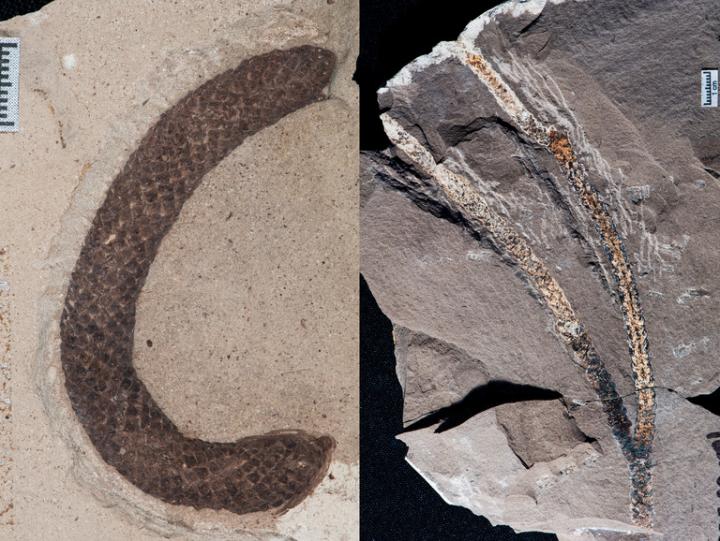
Credit: Gabriella Rossetto-Harris, Penn State
Newly unearthed, surprisingly well-preserved conifer fossils from Patagonia, Argentina, show that an endangered and celebrated group of tropical West Pacific trees has roots in the ancient supercontinent that once comprised Australia, Antarctica and South America, according to an international team of researchers.
“The Araucaria genus, which includes the well-known Norfolk Island pine, is unique because it’s so abundant in the fossil record and still living today,” said Gabriella Rossetto-Harris, a doctoral student in geosciences at Penn State and lead author of the study. “Though they can grow up to 180 feet tall, the Norfolk Island pine is also a popular houseplant that you might recognize in a dentist’s office or a restaurant.”
Araucaria grew all around the world starting about 170 million years ago in the Jurassic period. Around the time of the dinosaur extinction 66 million years ago, the conifer became restricted to certain parts of the Southern Hemisphere, said co-author Peter Wilf, professor of geosciences and associate in the Earth and Environmental Systems Institute (EESI).
Today, four major groups of Araucaria exist, and the timing of when and where these living lineages evolved is still debated, Rossetto-Harris said. One grows in South America, and the other three are spread across New Caledonia, New Guinea and Australia, including Norfolk Island. Many are now endangered or vulnerable species. The Norfolk pine group, the most diverse with 16 species, is usually thought to have evolved near its modern range in the West Pacific well after the Gondwanan supercontinent split up starting about 50 million years ago, Rossetto-Harris added.
Researchers from Penn State and the Museo Paleontológico Egidio Feruglio, Chubut, Argentina, found the fossils at two sites in Patagonia – Río Pichileufú, which has a geologic age of about 47.7 million years, and Laguna del Hunco, with a geologic age of about 52.2 million years. They analyzed the fossil characteristics and compared them to modern species to determine to which living group the fossils belonged. Then they developed a phylogenetic tree to show the relationships between the fossil and living species. They reported their findings in a recent issue of the American Journal of Botany.
Unlike the monkey puzzle trees of the living South American group of Araucaria, which have large, sharp leaves, the Patagonian conifer fossils have small, needle-like leaves and cone remains that closely resemble the Australasian Norfolk Island pine group, according to the researchers. They also found a fossil of a pollen cone attached to the end of a branch, which is also characteristic of the group.
“The new discovery of a fossil pollen cone still attached to a branch is rare and spectacular,” said Rossetto-Harris, who is also an EESI Environmental Scholar. “It allows us to create a more complete picture of what the ancestors of these trees were like.”
The researchers used 56 new fossils from Río Pichileufú to expand the taxonomic description of Araucaria pichileufensis, a species first described in 1938 using only a handful of specimens.
“Historically, scientists have lumped together the Araucaria fossils found at Río Pichileufú and Laguna del Hunco as the same species,” Rossetto-Harris said. “The study shows, for the first time, that although both species belong to the Norfolk pine group of Araucaria, there is a difference in conifer species between the two sites.”
The researchers named the new species from Laguna del Hunco Araucaria huncoensis, for the site where it was found. The fossils are about 30 million years older than many estimates for when the Australasian lineage evolved, according to Rossetto-Harris.
The findings suggest that 52 million years ago, before South America completely separated from Antarctica, and during the first few million years after separation was underway, relatives of Norfolk Island pines were part of a rainforest that stretched across Australasia and Antarctica and up into Patagonia, said Rossetto-Harris.
The change in the Araucaria species from the older Laguna del Hunco site to the younger Río Pichileufú site may be a response to the climatic cooling and drying that occurred after South America first became isolated.
“We’re seeing the last bits of these forests before the Drake Passage between Patagonia and Antarctica began to really widen and deepen and set forth a lot of big climatic changes that would eventually cause this version of Araucaria to go extinct in South America, but survive in the Australian rainforest and later spread and thrive in New Caledonia,” Rossetto-Harris said.
The study shows how tiny details can provide the definition needed to reveal big, important stories about the history of life, Wilf added.
###
In addition to Rossetto-Harris and Wilf, the research team includes Ignacio H. Escapa and Ana Anduchow-Colombo, Museo Paleontológico Egidio Feruglio.
The National Science Foundation, National Geographic Society, Botanical Society of America, Geological Society of America, and Penn State provided funding for this project.
Media Contact
A’ndrea Elyse Messer
[email protected]
Related Journal Article
http://dx.




